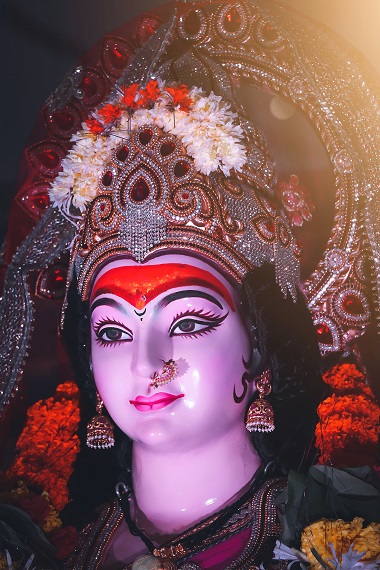
Menu

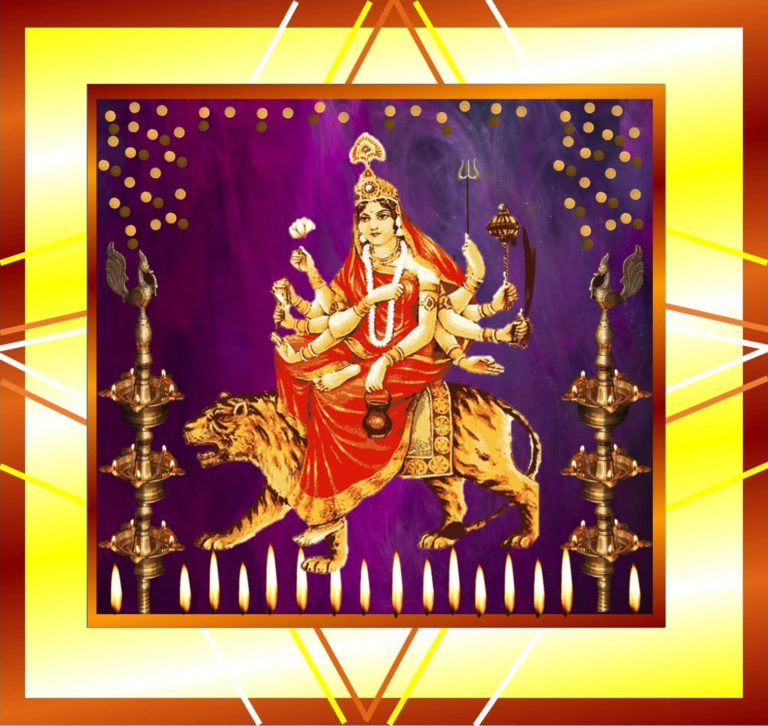
Got Questions? Contact Us Now:
Contact Number:
+ 1 – 647-540-2812 (Canada & USA #)
+ 91 – 888-268-1484 (India # – WhatsApp & BOTIM)
Email:
contact@liveonlinepuja.com
Durga Saptashati is a unique Hindu religious text describing the victory of Maa Durga over the demons as the supreme power and creator of the Universe.
Durga Saptashati is part of Markandeya Purana. It is called Durga Saptashati due to its 700 verses (Sapta meaning Seven). In this, a symbolic interpretation of the creation of the universe has been given while dividing the powers of the world in two forms accumulated and functional.
Durga Saptashati is usually recited during Navratri. Durga Saptashati defines the nature of the Divine Mother. Divine Mother (Devi Maa) is the unlimited Shakti (energy) behind all limited energies. Some devotees call her Maa Durga, some call her Maa Chandi, and some call her Maha Lakshmi. She is the root of all that manifests. Divine Mother is the force that drives everything in the Universe.
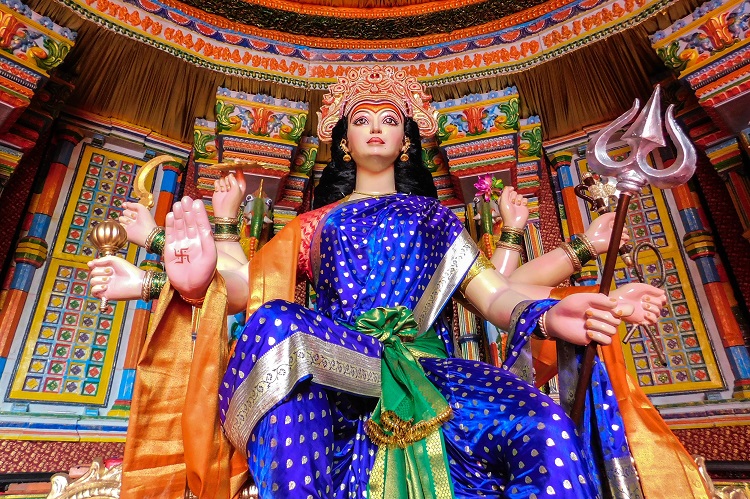
According to legend, the Maa Durga waged war against the terrible demons, which had destroyed the peace of the Universe. At that time, when the gods prayed for an intervention from a higher power, Maa Durga manifested and fought for the welfare of the Universe.
Maa Durga fought the battle and created tales of adventure and awe that enthralled her devotees and invoked deep faith in her.
These stories came to be known as Durga Saptashati in the north, Devi Mahatmya in the South of India and Chandi in West Bengal.
The text is called Saptashati (literally means “a collection of something in seven hundred numbers”), as it contains 700 verses (shlokas). The Durga Saptashati is a part of Markandeya Purana and constitutes Markandeya Purana’s chapters 81 through 93.
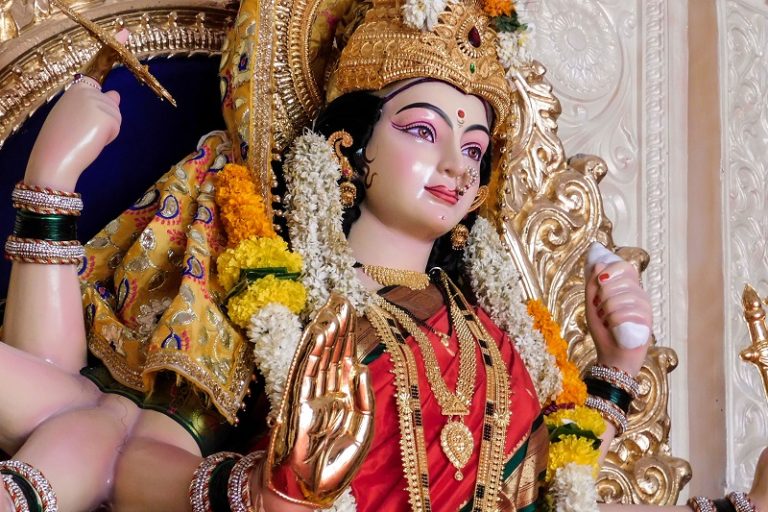
Consisting of 13 chapters, Durga Saptashati tells the stories of the heroism of the Goddess through 700 verses. It is a collection of stories of the battle between good and evil, in which the Devi manifests as Maa Durga and leads the forces of good against the demons. In peaceful times, the Devi manifests as Maa Lakshmi, empowering creation and happiness. Durga Saptashati describes reverence and worship of the feminine aspect of God in Hindu traditions. The Durga Saptashati, in some Hindu traditions, is considered as important as the Bhagavad Gita.
The Maa Durga defeated and killed the demons, such as Madhu, Kaitabha, Mahishasura, Dhumralochana, Chanda, Munda, Raktabija, Nishumbha, and Shumbha, through various incarnations. She kills some demons through the tamasic (punisher) incarnation of Goddess Kali, some through the rajasic (majestic) incarnation of Goddess Lakshmi, and some through the sattvik (righteous) incarnation of Goddess Saraswati.
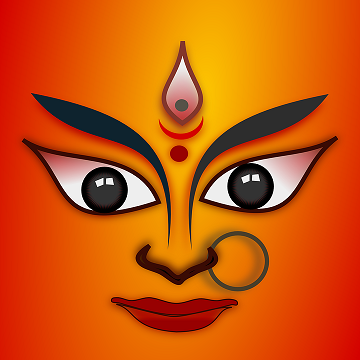
Sages composed stotras, methods, and kavach (armor) related to Maa Durga. They wanted that there should be such a composition in which all the three powers: Mahasaraswati, Mahalakshmi, and Mahakali are included together with the divine power. That is why they first composed ‘Ratri sukta’ and ‘Devi sukta.’ They composed seven hundred verses through which the characters of the Goddess were described. Those shlokas were related to Maa Durga. That is why it was named Durga Saptashati.
The seven hundred verses of Durga Shaptashati are divided into 13 chapters. These thirteen chapters of Durga Saptashati are divided into three charitras or episodes (Pratham charitr, madhyam charitr, and uttam charitr).
Mahakali is described in the first episode, Mahalakshmi in the middle episode, and Mahasaraswati in the final episode.
The first episode is the story of Madhu Kaitabh’s slaughter. In the middle episode, there is the story of the killing of Mahishasura along with his army. In the final episode, there is the story of Shumbhat Nitshumbhai slaughter and the boon of the Goddess given to king Suratha and Vaishya (Merchant).
The first episode has only the first Chapter; the middle episode has the second, third, and fourth chapters, and the final episode has the remaining chapters. In the first episode, the syllable form ‘क्लीं’ (kleen) represents Maa Kali, in the middle episode, Maa Lakshmi’s syllable form is ‘ह्रीं’ ( ‘Hreem’), and in the final episode, Maa Saraswati’s syllable form is ‘ऐं’ (‘Ai’).
In this way – ‘ऐं ह्रीँ क्लीं चामुण्डायै विच्चे’ (‘Aim Hreem Klein Chamundayai Viche’) – this mantra is Navarna (navaksharee) Mantra. In this, there are a total of nine letters, which represent the nine Durgas. The meaning is that the nine Durgas are the collective power, that is, the power of the Navarna mantra.
When the kingdom of a king named Suratha is snatched away, and life is in danger, that king runs away and goes to the forest. The wise king has the right knowledge of his situation. He certainly understands that he is not going to get back his kingdom or any property again. But still, he keeps on worrying about the same things, persons and treasures, etc., again and again.
Unlike what the king considers useless and wants to be free, his mind is drawn towards those things, ignoring his knowledge. The wise king Suratha goes to the supreme wise Megha Rishi with his extraordinary doubts. The Sage tells him that Mahamaya (Maa Durga) is the special power that unites the whole world, governs, organizes, and controls the whole creation. All living beings work under her inspiration.
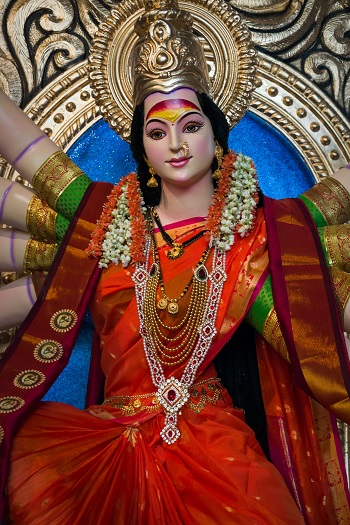
This Mahamaya Shakti (Divine Mother/Maa Durga) governs the three stages of creation in three forms. Creation is a constant change of states. Time is the measure of change. Change cannot be imagined without time. Therefore, in the first stage, this Mahamaya in the form of Mahakali Shakti gives speed to the creation.
She maintains and nurtures her in the form of Mahalakshmi. The third stage of creation is the advanced stage of development when there is a multidimensional development of consciousness. She conducts and controls this state in the form of Mahasaraswati. These three stages of creation have been presented in an understandable form of Durga Saptashati to the common man.
These three stages are governed by the Tridevi, Mahakali (Chapter 1), Mahalakshmi (Chapters 2-4), and Mahasaraswati (Chapters 5-13). In the first stage, two demons named Madhu and Kaitabh wanted to kill Lord Brahma, the creator of the Universe. Tamoguni and Rajoguni, respectively, these two extreme forces are a threat to development.
Brahma Ji pleaded for protection to Mahamaya. Inspired by Mahamaya, Lord Vishnu renounced sleep and killed the demons. The work of creation of Brahma Ji goes ahead. The second stage is a symbolic description of the early stage of civilization – the then wild stage of the Gangetic Indus plain.
The human group, relatively weak in physical force from animals – Adishakti had to choose to take the vehicle of her civilization from among the terrible wild animals like wild buffalo (Mahishasura), etc., without developed weapons, only on the strength of her intelligence, in which she succeeded. The third stage is the advanced stage of civilization, where the Adishakti has to face the two extreme forces Rajoguna and Tamoguna, or progressive and reactionary forces in the form of Shumbh and Nishumbha.
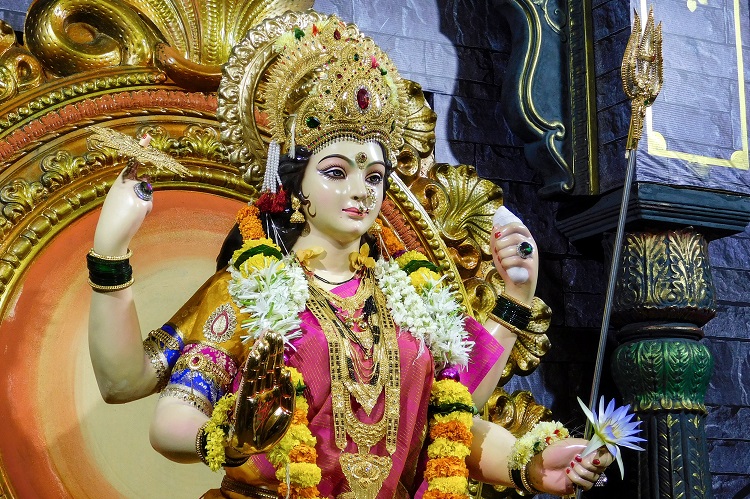
The tales of Devi symbolize the power of good over evil which is the eternal truth. Devotees recite the Durga Saptashati at their homes during the nine days of Navratri. Listening to the glories of the Goddess makes the devotee realizes her omnipotence.
The twelfth Chapter of Durga Saptashati tells of the benefits of reciting this sacred text, as told by the Goddess herself to the deities. The benefits of recitation Of Durga Saptashati are:
• By the recitation of Durga Saptashati, the Goddess’s presence could be felt at the Place of the recitation.
• The recitation of Durga Saptashati the end of all suffering and troubles of the devotee.
• The recitation of Durga Saptashati is beneficial for disaster prevention.
• Its recitation removes the poverty of the devotees and bestows them with wealth and prosperity.
• The recitation of Durga Saptashati protects the devotee from enemies, fire, and flood.
• Recitation of Durga Saptashati protects from Malefice planetary influences.
• Recitation of Durga Saptashati protects from evil spirits and black magic.
• The recitation of Durga Saptashati leads to the acquisition of money, food, and children.
According to pundits and experts, Durga Saptashati is an effective and intensely effective text in today’s Kali Yuga. If it is used properly, a person can get rid of all kinds of problems.
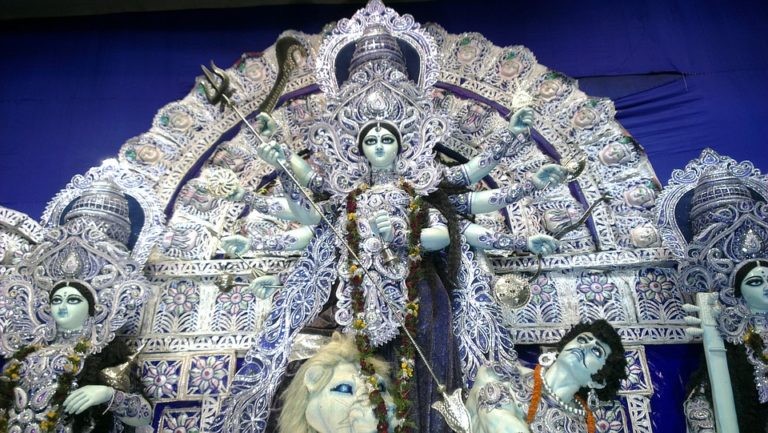
It is said that the recitation of each Chapter of Durga Saptashati gives different results. Special wish is fulfilled by each Chapter of Durga Saptashati, which is as follows:
• Recitation of the FIRST CHAPTER of Durga Saptashati gets rid of worries. This removes the fear of the enemy and pacifies the obstacles of the enemies.
• The recitation of the SECOND CHAPTER leads to victory in court cases and disputes. But keep in mind that Goddess helps only those who are true and honest. Also, one can get rid of false allegations.
• If you are troubled by enemies and opponents, then regularly read the THIRD CHAPTER.
• For the devotion and grace of Maa Durga, read the FOURTH CHAPTER. Its recitation leads to a good life partner.
• By the recitation of the FIFTH CHAPTER, the infinite compassion of the Goddess is obtained. Mata removes the problems of the devotees. Its recitation destroys negative energy. It destroys the obstacle of fear, nightmares, and tantra mantra (black magic).
• Freedom from fear, doubt, black magic obstacles is obtained from the recitation of the SIXTH CHAPTER.
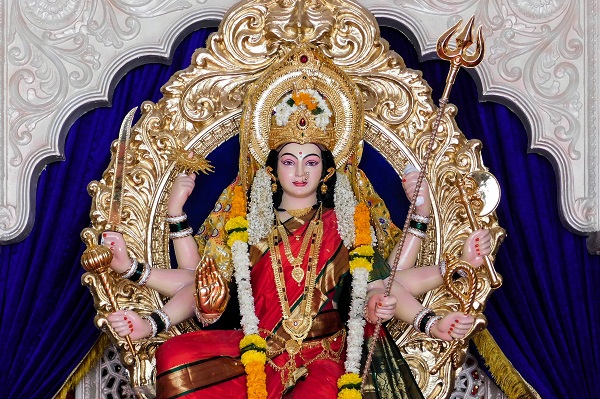
• Recite the SEVENTH CHAPTER to fulfill a special wish. In this Chapter, there is the story of the killing of Chand Mund by the Goddess.
• Recitation of the EIGHTH CHAPTER is considered effective to get captivating and desired partner. In this Chapter, there is a story of the killing of Raktabeej. Its recitation gets money regularly.
• The Recitation of the NINTH CHAPTER is considered effective for bringing back lost persons and the happiness of children. With its recitation, one gets benefits from the property. This Chapter contains the story of the killing of Nishumbha.
• In the TENTH CHAPTER, there is a story of Shumbh slaughter. The recitation of this Chapter destroys disease and grief. Unparalleled power and child happiness are attained. One can also recite this Chapter for the fulfillment of desires.
• From the recitation of the ELEVENTH CHAPTER, profit and happiness in business are attained. Its recitation removes all worries.
• From the recitation of the TWELFTH CHAPTER, one gets the benefit of respect and happiness. Its recitation gets rid of diseases.
• Devotion and grace of the Goddess are received from the recitation of the THIRTEENTH CHAPTER. Also, a person is protected from all kinds of trouble.
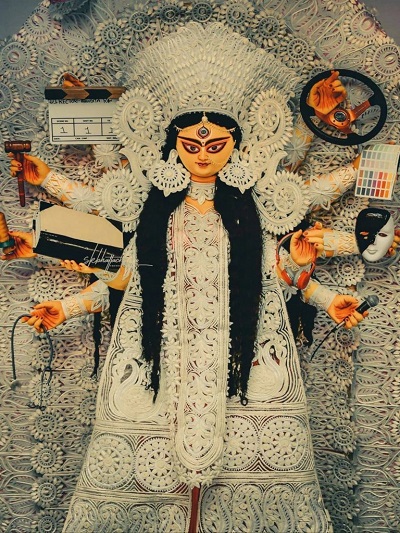
Durga Saptashati recitation every day of the week has its own importance. According to the weekday, its recitation is said to give different results. The tales of Devi symbolize the power of good over evil. By listening to the glories of the Goddess, the devotee realizes her omnipotence. The benefits of recitation increase many folds depending upon the weekday on which recitation is done. The benefits of recitation of Durga Saptashati text from Monday to Sunday are:
• SUNDAY: A person who recites Durga Saptashati on Sunday gets nine times more results.
• MONDAY: Similarly, reciting Durga Saptashati on Monday gives one thousand times the result.
• TUESDAY: By reciting Durga Saptashati on Tuesday, one gets the merit of doing a hundred recitations.
• WEDNESDAY: Reciting Durga Saptashati by meditating on the Maa Durga on Wednesday will give the fruit of one lakh recitations.
• THURSDAY & FRIDAY: The result of worshiping the Maa Durga by reciting Durga Saptashati on Thursday and Friday is equal to the fruit of two lakh Chandi recitations.
• SATURDAY: On Saturday, reciting Durga Saptashati by meditating on the Maa Durga is equal to the fruit of one crore Maa Chandi recitations.
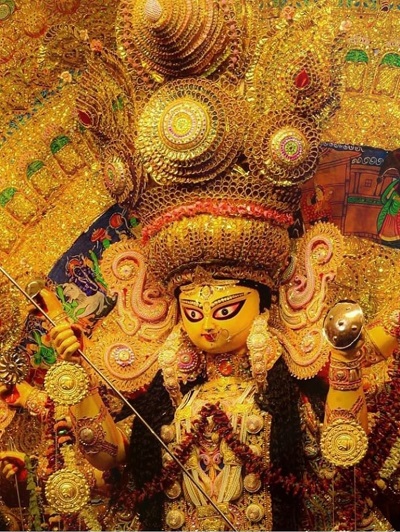
In Sanatan Dharma, there are four festivals in the year of worship of Shakti, two of which are Chaitra Navratri and Shardiya Navratri, while the other two are called Gupt Navratri, all of them have special significance in worship of Shakti. In the nine days of Navratri, it is said that many specific tasks are accomplished by worshiping the Devi Maa. Goddess is considered a symbol of power in Sanatan Dharma. Therefore, power is required to do any work; in such a situation, the Devi Maa is invoked.
Reciting Durga Saptashati in Navratri is particularly fruitful. The mantras written in it not only protect one from various diseases, but this recitation of Durga Saptashati proves to be especially fruitful. Apart from this, devotees recite Saptashati throughout the year and please the Devi Maa and get her blessings. The Durga Saptashati recitation every day of the week has its own importance. According to the weekday, its recitation is said to give different results.
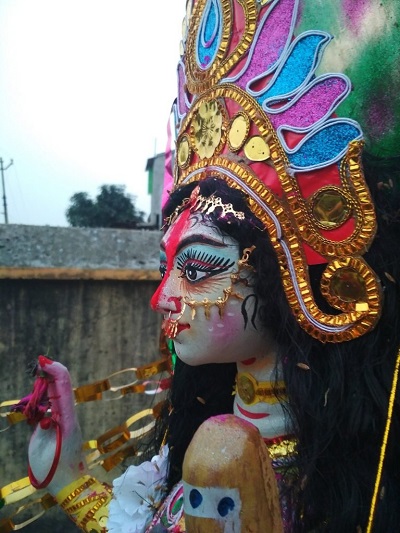
In the recitation of Durga Saptashati, there is an importance of reciting with clear pronunciation and rhythm. It has been told in the Saptashati that the recitation should be done so that each word is pronounced clearly and you can hear it. Don’t recite too loudly or slowly.
One should not touch feet with hands while reciting; if touching feet, wash hands with water.
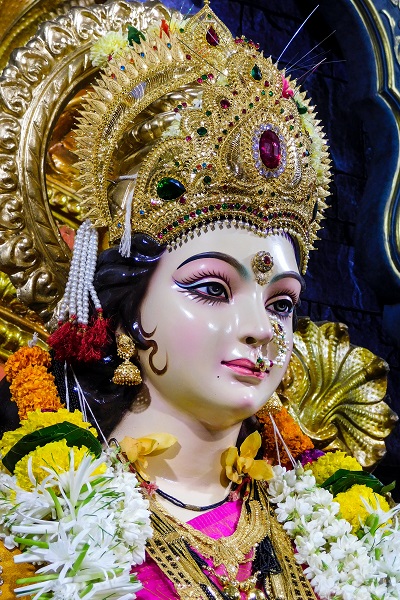
Kush (Grass) posture should be used for reciting. If it is not available, then a woollen sheet or woollen blanket can be used.
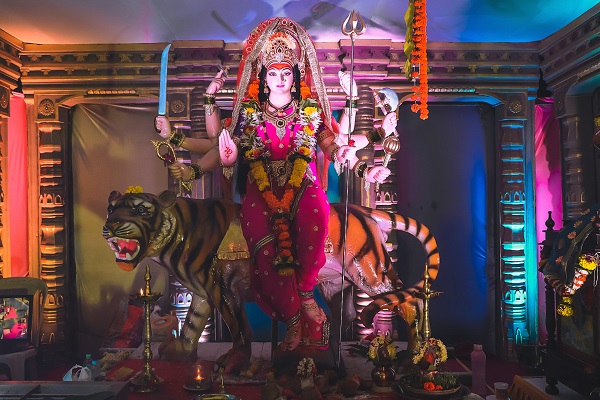
One must ring the holy bells (Ghanti) before the start and end of a chapter of Durga Saptashati.
Navangam is a process in which nine prayers are recited before the main text is recited.
The nine prayers are:
Devi Nyasa, Devi invocation, Devi Namami, Argali Stotram, Keelka Stotram, Devi Hrday, Dhala, Devi Dhayan, Devi Kavach.
After reciting the above prayers, chapters of Durga Saptashati are recited.
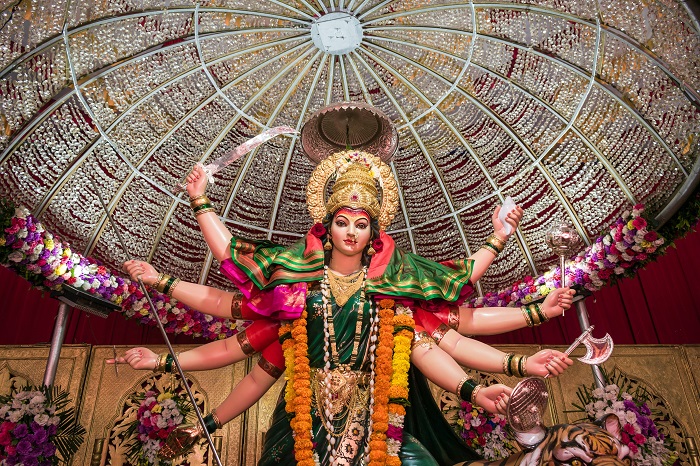
Durga Saptashati is also recited during Navratri, with chapters divided into nine days:
• DAY 1 – Chapter 1 – Madhu Kathabha slaughter.
• DAY 2 – Chapter 2, 3, 4 – Mahishasur slaughter.
• DAY 3 – Chapter 5 and 6 – Dhumralochan slaughter.
• DAY 4 – Chapter 7 – Chand Munda Slaughter.
• DAY 5 – Chapter 8 – Raktabeej slaughter.
• DAY 6 – Chapter 9 and 10 – Shumbha Nishumbha slaughter.
• DAY 7 – Chapter 11 – Stuti Narayani.
• DAY 8 – Chapter 12 – Phal Shruti.
• DAY 9 – Chapter 13 – Goddess who blessed King Suratha and Vaishya (merchant).
• DAY 10 – (Vijayadashmi-Dussehra)- Devi aparaadha akshama (Crime forgiveness) Stotra is recited.
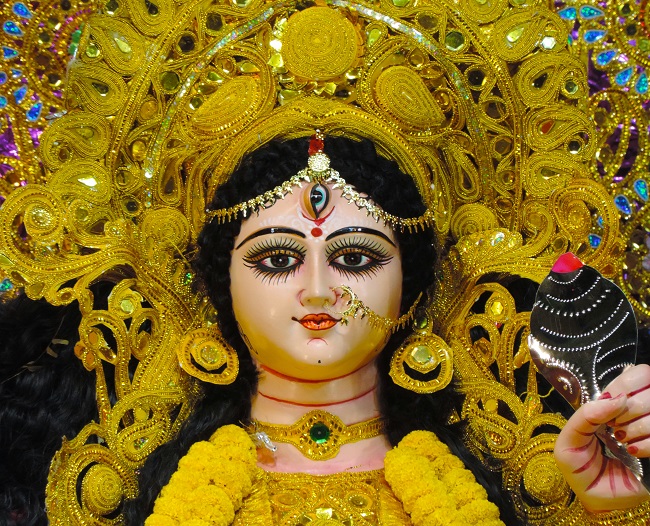
It is believed that in the earlier times, people used to be absorbed in the devotion of the Maa Durga during Navratri and preferred to spend all their time at the feet of the Devi Maa. But it has been seen that in today’s run-of-the-mill life, the devotees are unable to make full time for the Goddess in Navratri. In such a situation, if one has not been able to give full time and attention to the worship of Devi Maa due to some reasons, then there is a way by which one can please the Devi Maa.
One can easily please the Devi Maa by reciting Durga Saptashati. On the other hand, if one has not been able to do the recitation on other days, then even on the day of Ashtami, by reciting Durga Saptashati with full devotion, almost all the wishes are fulfilled.
Durga Saptashati recitation is done especially in Navratras, and it gives unimaginable results.
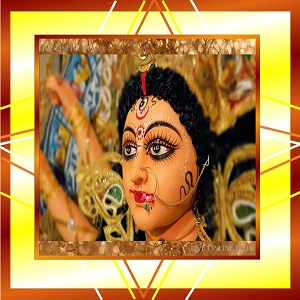
FIRST DAY – One Chapter
SECOND DAY – Two Chapters
THIRD DAY – One Chapter
FOURTH DAY – Four Chapters
FIFTH DAY – Two Chapters
SIXTH DAY – One Chapter
SEVENTH DAY – Two Chapters
• First of all, worship ‘Guru’ and Ganesh Ji, etc., and in front should establish a lighted lamp. Then one should meditate on Bhagwati Durga in the light of that lamp.
• After meditation, worship the Maa Durga with Panchopchar / Dashopchar / Shodashopchar – after that, recite Durga Saptashati according to the method mentioned above.
• Durga Saptashati recitation (in order of day mentioned above). Ring bell before the start and of a chapter.
• After this, pray for forgiveness from the Devi Maa – the hymn of forgiveness prayer is also in Saptashati.
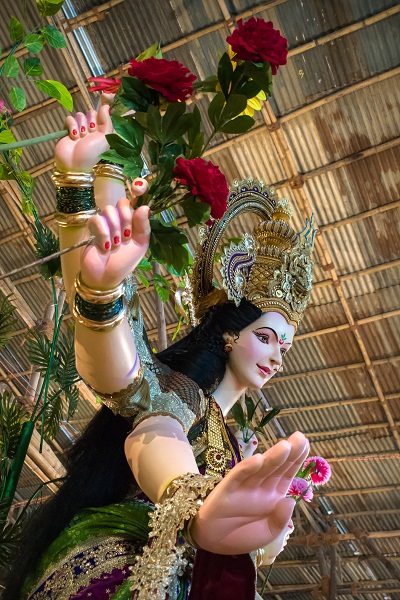
The Siddha-Mantra of Durga Saptashati means that those mantras which are used for Maa [Durga], i.e., bowing down to Maa Durga while dedicating oneself at her feet and chanting her Siddha mantras, which pleases Maa Durga. She gives the opportunity to her devotees to get the desired results. There are different types of mantras of Siddha-mantra of Durga Saptashati, which depend on each one’s wishes, and by chanting these mantras at least 11, 21, 51, or 108 times, that person’s wish is fulfilled.
Navarna Mantra has been called Mantraraj. (King of Mantras).
।। ॐ ऐं ह्रीं क्लीं चामुण्डायै विच्चे ।।
Om Ain Hreem Kleem Chaamundaayai Vichche
।। क्लीं ह्रीं ऐं चामुण्डायै विच्चे ।।
Kleem Hreem Aim Chaamundaayai Vichche
।। ओंम ऐं ह्रीं क्लीं चामुण्डायै विच्चे ।।
Om Aim Hreem Kleem Chaamundaayai Vichche
।। क्लीं ऐं ह्रीं चामुण्डायै विच्चे ।।
Kleem Aim Hreem Chaamundaayai Vichche
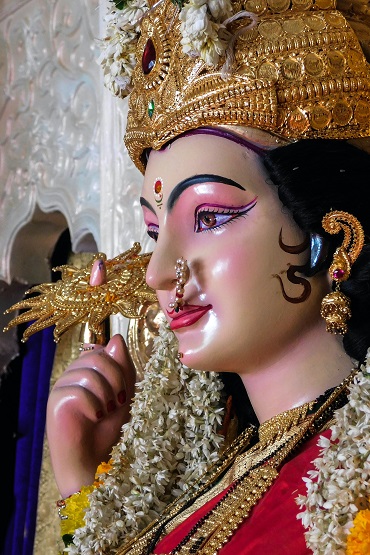
The Durga Saptashati consists of chapters 81-93 of the Markandeya Purana, one of the early Sanskrit Puranas. The thirteen chapters of Durga Saptashati are divided into three charitras or episodes (Pratham charitr, madhyam charitr aur uttam charitr). At the beginning of each episode, the presiding Goddess invoked is different.
The introductory narrative of Durga Saptashati stages a king who was dispossessed of his kingdom, a merchant, who was betrayed by his family, and a sage whose teachings lead them both beyond material suffering.
The Sage tells them the three different epic battles between the Maa Durga and various demons. (The three stories are governed by the holy trinity, Mahakali (Chapter 1), Mahalakshmi (Chapters 2-4), and Mahasaraswati (Chapters 5-13). The most famous tale is of Mahishasura Mardini – Devi as “Slayer of the Buffalo Demon- Mahishasura.’
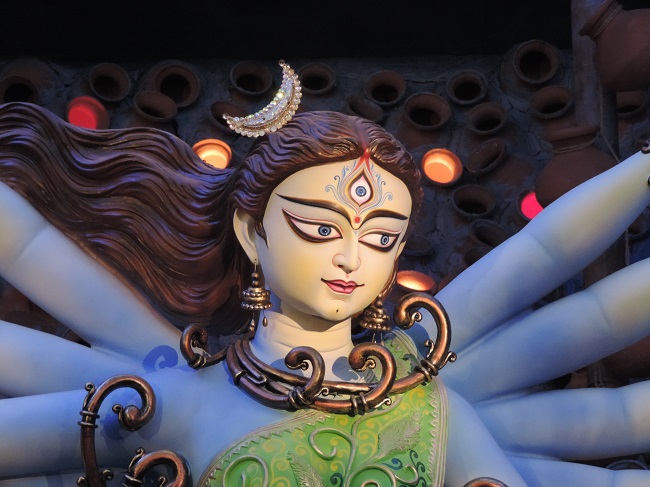
Durga Saptashati is a Hindu religious text describing the victory of the Goddess Durga over the demon and contains 700 verses, arranged into 13 chapters. The thirteen chapters of Durga Saptashati are divided into three charitas or episodes (Pratham charitr, madhyam charitr aur uttam charitr). The first episode, the first Chapter, describes the glory of Maha Kali, the second, third, and fourth chapters glorify Maha Lakshmi. The last nine chapters from the fifth to the thirteenth glorify Maa Saraswati.
The first episode begins with the Meditation of Mahakali. It contains only one Chapter. The first Chapter of the Durga Saptashati describes the glory of Maha Kali. Here Devi, the central and key to the creation or, induces Lord Vishnu into a deep (mystic) sleep on the waters of the cosmic ocean prior to the manifestation of the Universe. Two demons, Madhu-Kaitabh, arose as thought forms from the sleeping body of Lord Vishnu and tried to slay Brahma Ji, who is preparing to create the next cycle of the Universe.
Brahma Ji invoked to the Great Goddess, asking her to withdraw from Lord Vishnu so he may awaken and slay the demons. Devi agrees to withdraw, and Lord Vishnu awakens and slays the demons. Here Devi Maa is praised as the agent who allows both the cosmic order to be upset & restored.
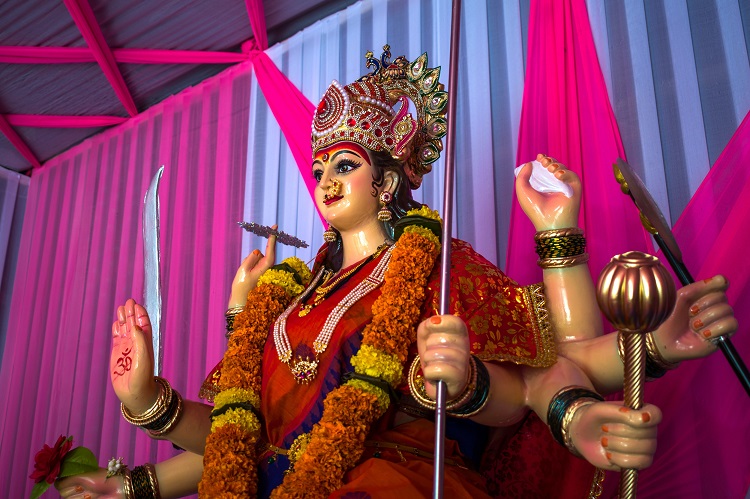
The middle episode (chapters 2-4) stages Goddess Mahalakshmi in her incarnation as Maa Durga. Maa Durga, a great Warrior Goddess, symbolizes divine anger and the lethal energy against evil. The episode presents a world that is under attack by the shape-shifting demon ‘Mahishasura”, who uses deception to disarm his opponents by taking the form of a buffalo.
Mahishasura defeats the male gods individually, who fear the destruction of the forces of good. Then all the Gods combine their individual energies to form a singular mass of Shakti from which Mahalakshmi is born as the endowed Maa Durga. Riding a lion into battle, Maa Durga captures and slays the buffalo demon by cutting off his head. Maa Durga then destroys the demon, thereby establishing order in the world.
In the spiritual practices of the goddess tradition of Hinduism, the middle episode is the most significant. If one cannot recite the entire Devi Mahatmyam composition, the middle episode alone is recited at a Puja or festival.
The final episode (chapters 5-13) depicts Maa Durga in her form of Mahasaraswati. She is portrayed as arising from Devi Parvati. Devi Kali is considered to represent the darker chthonic, transformative qualities of Devi’s power or Shakti. Maha Kali’s emergence is chronicled in the 7th Chapter. In the form of Maa Chamunda, Maha Kali emerges from Maa Durga as a burst of psychic energy. Maha Kali overpowers and beheads Chanda and Munda, and when she delivers their severed heads to Devi, she is called Chamunda.
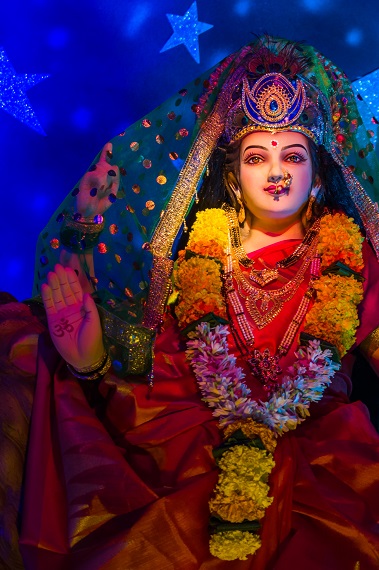
During a fierce battle in which Maa Durga demonstrates her omnipotence by defeating powerful demons who terrify the devas, she encounters the fierce Raktabeej (chapter 8). Every drop of blood Raktabeej sheds transforms into another demon as soon as it touches the earth. A unique plan has to be devised to defeat him. While Devi Kaushiki attacks him with various weapons, Maha Kali, with her huge mouth and enormous tongue, drank up Raktabeej blood, thus preventing the uprising of further demons.
The story continues in which Devi, Maha Kali destroys the demonic brothers Sumbha (chapter 10) and Nisumbha (chapter 9). In the final battle against Shumbha, Maa Durga absorbs Kali and stands alone for the final battle. Praise of the Goddess by the Gods and Boons to the Gods by the Goddess is narrated in Chapter 11. Chapter 12 narrates the Glory and Fruits of the recitation of Goddess doings, and Chapter 13 narrates the bestowing of boons to Suratha and Vaisya.
The second Chapter of Durga Saptashati is based on “The incarnation of Maa Durga by the effulgence of the gods and the Slaughter of the armies of Mahishasura.”
